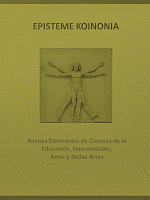Storytelling to Improve Speaking Skills
DOI:
https://doi.org/10.35381/e.k.v5i9.1665Palabras clave:
Language instruction, second language instruction, bilingual education. (UNESCO Thesaurus).Resumen
This study aims to establish the effectiveness of storytelling to increase the speaking skills of adolescent students at high school level; through, a mixed methods analysis using as data collection technique: the survey. This instrument was applied to tenth grade students of the Remigio Romero y Cordero Educational Unit in Cuenca. The survey was used to collect data to evaluate the impact of the oral expression activities and the students' perceptions, experiences, opinions and points of view. With these results obtained, a proposal emerges for the foreign language teachers of the Remigio Romero y Cordero Educational Unit in Cuenca, on the benefits of applying storytelling with adolescents, its effectiveness in improving the level of language proficiency and recommendations for its implementation in schools.
Descargas
Citas
Abderrahim, L., & Plana, G. C. M. (2021). A theoretical journey from social constructivism to digital storytelling. The EuroCALLview, 29(1), 38-49. https://doi.org/10.4995/eurocall.2021.12853
Aisyah, S., & Setiawan, D. (2009). The Use of High Order Thinking Skill in Story Telling Method in Order to Improve Children' Critical Thinking. Journal of English and Education, 3(1). https://doi.org/10.20885/jee.vol3.iss1.art2
Albaladejo, S., & Coyle, Y. D. (2018). Songs, stories, and vocabulary acquisition in preschool learners of English as a foreign language. Elsevier Journal, 76, 116-128. doi:https://doi.org/10.1016/j.system.2018.05.002
Atta-Alla, M. N. (2012). Integrating language skills through storytelling. Canadian Center of Science and Education, 5(12), 1-14. doi:10.5539/elt.v5n12p1
Denning, S. (2021). What are the main types of stories and narratives? Retrieved from https://n9.cl/yrura
Dvalidze, N. (2017). Teaching English Language Through Storytelling. Journal of Teaching and Education, 6(2), 53-58. Retrieved from https://n9.cl/8rpb5
Gutierrez, M., Cristobal, I., Alonzo, A., & Bustamante, R. (2019). Digital Storytelling vs Traditional Storytelling: Teaching English Language to ANHS Students. IEEE Integrated STEM Education Conference (ISEC), 38-41. doi:10.1109/ISECon.2019.8882047
Haigh, C., & Hardy, P. (2011). Tell me a story a conceptual exploration of storytelling in healthcare education. Nurse Education Today, 31(4), 408-411. https://doi.org/10.1016/j.nedt.2010.08.001
Hennebury, C. (2020). Storytelling is not just entertainment. It's a fundamental part of being human. (C. N.L., Ed.) Retrieved from https://n9.cl/aqsve
Khodabandeh, F. (2018). The impact of storytelling techniques through virtual instruction on english students’ speaking ability. Teaching English with Technology, 18(1), 24-36. Retrieved from https://n9.cl/0svwp
Koki, S. (1998). Storytelling: The Heart and Soul of Education. Pacific Resources for Education and Learning, 1- 4. Retrieved from https://n9.cl/m7ndz
Krashen, S. (2010). Stephen Krashen on Language Acquisition [Video file]. Retrieved from https://n9.cl/lbmyi
Krashen, S. D. (1981). Second Language Acquisition and Second Language Learning. California, USA: Oxford University Press.
Krashen, S. D. (1985). The Input Hypothesis. Issues and Implications. 76 - 109. Retrieved from https://n9.cl/thkvg
Lewis, R. (2020). What Is Comprehensible Input and Why Does It Matter for Language Learning? [Blog post]. Retrieved from https://n9.cl/1ty3e
Li, C. Y., & Seedhouse, P. (2010). Classroom Interaction in Story-Based Lessons with Young Learners. Asian EFL Journal, 12, 288-312.
Lisenbee, P., & Ford, C. (2018). Engaging Students in Traditional and Digital Storytelling to Make Connections Between Pedagogy and Children’s Experiences. Early Childhood Education Journal, 46(1), 129-139. https://doi.org/10.1007/s10643-017-0846-x
Lucarevschi, C. R. (2016). The Role of Story Telling in Language Learning: A literature review. Working Papers of the LInguistic Circle, 26(1), 24-44. Retrieved from https://journals.uvic.ca/index.php/WPLC/article/view/15309
McKim, C. A. (2017). The Value of Mixed Methods Research: A Mixed Methods Study. Journal of Mixed Methods Research, 1 -21. https://doi.org/10.1177/1558689815607096
Moulton, L. (2020). How to make storytelling effective for all learners [Blog postt]. Retrieved from https://n9.cl/yp65k
Munaro, A. C., & Pianovski Vieira, A. M. (2016). Use of transmedia storytelling for teaching teenagers. Creative Education, 7(07), 1-11. doi:10.4236/ce.2016.77105
National Geographic. (2020). Storytelling. Retrieved from https://n9.cl/t4iwk
Normann, A. (2011). DIGITAL STORYTELLING (Master Thesis in Didactics for English and foreign languages), Norwegian University of Science and Technology. 1-124. Retrieved from https://n9.cl/4mj25
Nozima, S. (2021). The use of short stories in teaching english to teenagers. Scientific Journal Impact Factor, 1(4), 1287-1291. Retrieved from https://n9.cl/nsjdz
Popova, N. (2019). Storytelling with teenagers: general ideas. Skyteach [Blog post]. Retrieved from https://n9.cl/0lxwf
Razmi, M., Pourali, S., & Nozad, S. (2014). Digital Storytelling in EFL Classroom (Oral Presentation of the Story): A Pathway to Improve Oral Production. International Conference on Current Trends in ELT, 1541-1544. doi:10.1016/j.sbspro.2014.03.576
Reddington, E., Yu, D., & Tadic, N. (2019). A tale of two tasks: Facilitating storytelling in the adult English as a second language classroom. The Embodied Work of Teaching, 81-99. doi:10.21832/9781788925501-008
Robin, B. R. (2008). Digital Storytelling: A Powerful Technology Tool for the 21st Century Classroom. Routledge, 220 - 230. doi:10.1080/004058408021539
Saritepeci, M. (2021). Students’ and Parents’ Opinions on the Use of Digital Storytelling in Science Education. Technology, Knowledge and Learning, 26(1), 193-213. doi: https://doi.org/10.1007/s10758-020-09440-y
Satriani, I. (2019). Storytelling in teaching literacy: Benefits and challenges. English Review. Journal of English Education, 8(1), 113-120. https://doi.org/10.25134/erjee.v8i1.1924
Sibierska, M. (2017). Storytelling without telling: The non-linguistic nature of narratives from evolutionary and narratological perspectives. Language and Communication, 54, 47-55. https://doi.org/10.1016/j.langcom.2016.10.005
Singh, S., Malik, S., & Singh, P. (2016). Factors Affecting Academic Performance of Students. Indian Journal of Research, 5(4), 176-178.
Thambu, N. (2017). Storytelling and Story Reading: A Catalyst for Inculcate Moral Values and Ethics among Preschoolers. The International Journal of Academic Research in Business and Social Sciences, 7(6), 1116-1130. doi:10.6007/IJARBSS/V7-I6/3143
Thompson, R., & McIlnay, M. (2019). Nobody wants to read anymore! Using a multimodal approach to make literature engaging. CLELEjourna, 7(1), 61-80. Retrieved from https://n9.cl/mg4uz
Wilson, M. (2018). Performance and Practice: Oral Narrative Traditions Amongst Teenagers in Britain and Ireland. Britain: Routledge.
Yilmaz, R., & Cigerci, F. (2018). A Brief History of Storytelling. IGI Global, 1-12. doi:10.4018/978-1-5225-5357-1.ch001
Publicado
Cómo citar
Número
Sección
Licencia
CC BY-NC-SA : Esta licencia permite a los reutilizadores distribuir, remezclar, adaptar y construir sobre el material en cualquier medio o formato solo con fines no comerciales, y solo siempre y cuando se dé la atribución al creador. Si remezcla, adapta o construye sobre el material, debe licenciar el material modificado bajo términos idénticos.
OAI-PMH URL: https://fundacionkoinonia.com.ve/ojs/index.php/epistemekoinonia/oai







